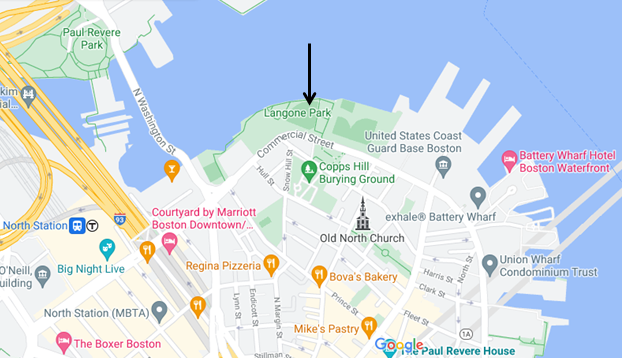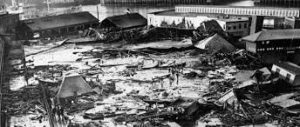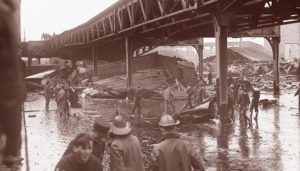 A massive molasses storage tank ruptured in downtown Boston, Massachusetts at 12:40 pm on Wednesday, January 15, 1919. 2.3 million gallons of liquid sludge, weighing over 12,000 tons, burst from the receptacle and sent a surge of brown death onto Boston’s streets. The sickly sweet wave was 40 feet high and moved at 35 miles per hour. When the sugary flood stopped, 21 people were dead and over 150 suffered injuries. Property damage was in the millions, and the legal outcome changed business practices across America. Sadly, the Boston Molasses Disaster, or Boston Molasses Flood, was perfectly preventable.
A massive molasses storage tank ruptured in downtown Boston, Massachusetts at 12:40 pm on Wednesday, January 15, 1919. 2.3 million gallons of liquid sludge, weighing over 12,000 tons, burst from the receptacle and sent a surge of brown death onto Boston’s streets. The sickly sweet wave was 40 feet high and moved at 35 miles per hour. When the sugary flood stopped, 21 people were dead and over 150 suffered injuries. Property damage was in the millions, and the legal outcome changed business practices across America. Sadly, the Boston Molasses Disaster, or Boston Molasses Flood, was perfectly preventable.
The molasses tank (reservoir or container, if you will) belonged to the Purity Distillery Company owned by United States Industrial Alcohol (USIA). It was 50 feet tall (five stories), 90 feet in diameter, and had a circumference of 283 feet. At the time, the Boston molasses tank was the city’s largest liquid storage facility. It was also the deadliest.
In January 1919, Boston was a happening place. The U.S. concluded World War I efforts two months earlier and was on the verge of Prohibition being enacted. Alcohol was in huge demand, both recreational for making spirits and industrial for manufacturing explosives. Molasses was a staple source for both, and Boston was an ideal spot for storing molasses.
Through Purity Distilling, USIA owned a strategic location on Commercial Street at Boston’s north end waterfront. It’s now a public place called Langone Park. The tank site was adjacent to a wharf where longshoremen could unload molasses tankers arriving from sugar cane plantations in the West Indies, pump the slurry mix to the receptacle, and then load it into rail cars when needed by USIA’s Purity distillery in Cambridge, west of downtown Boston.

The tank’s construction began in 1915, but it suffered delays. Completion occurred in 1917 and it went into operational use with little testing applied. Immediately, molasses leaks appeared at riveted seams where the metal panels overlapped. Many nearby residents, mostly Italian immigrants, complained of the unsightly mess and unfavorable smell. USIA’s response was not to fix the leaks but paint the tank brown to mask the molasses stains.
People complained about more than the appearance and the odor. Employees who worked around the tank heard creaks and groans coming from within the molasses storage unit. They felt shudders and shakes when the tank was loaded and unloaded, and they sounded their concerns about the structural integrity of the hastily-built monstrosity. Their voices fell on deaf management ears.
On January 12, 1919, the shaky tank took on a 1.3 million gallon load of Cuban molasses. The tank was at its highest-ever capacity with an overall weight of 26 million pounds. The molasses sat until the Wednesday morning when the sun came up and began an unusual temperature gain for that time of year.
Without warning, at 40 minutes past noon, the molasses tank ruptured at its bottom seams. A massive force sent metal debris flying as heavy-weight shrapnel with the gooey molasses mess radiating in a four-story-high wave knocking buildings off their foundations, smashing their wood frames to smithereens, toppling freight cars, and killing these innocent people:
Patrick Breen, age 44
William Brogan, age 61
Bridget Clougherty, age 65
Stephen Clougherty, age 34
John Callahan, age 43
Maria Di Stasio, age 10
William Duffy, age 58
Peter Francis, age 64
Flaminio Gallerani, age 37
Pasquale Iantosca, age 10
James Kenneally, age 48
Eric Laird, age 17
George Lehaye, age 38
James Lennon, age 64
Ralph Martin, age 21
James McMullen, age 46
Cesar Nicolo, age 32
Thomas Noonan, age 43
Peter Shaughnessy, age 18
John Seiberlich, age 69
Michael Sinnott, age 78
First responders were overcome with one main obstacle. That was trying to move in the 2 to 3-foot deep pool of semi-liquid molasses that thickened as the day cooled and the goo dropped to the ambient temperature of Boston’s wintertime. It took 4 days to recover nearly-unrecognizable bodies and decontaminate them so identification could be made.

Medical workers established a field hospital to treat assorted injuries like broken bones, crushed organs, and obstructed airways. Cleanup efforts took months. And the molasses smell remained ingrained in Boston’s air for years. Today, over 100 years later, local legend says you can still whiff molasses on hot summer nights.
The Investigation and Legalities Began
Someone had to be accountable for Boston’s monstrous molasses massacre. Those were the people managing USIA’s storage facility in North Boston, and the process would take six years. Eventually, no individual was prosecuted for a criminal act although the utter negligence displayed in (lack of) planning, overseeing, and commissioning the molasses tank’s construction was outrageous.
Two factors drove the need for such a large molasses container. First was the marketplace because, at the Roaring Twenties onset, there was a highly-profitable demand for recreational and industrial alcohol. The USIA executives wanted to capitalize on molasses-based alcohol products as quickly as possible. Strike while the iron’s hot, as they say.
Second was the onset of Prohibition. The Eighteenth Amendment was ratified the day after the Boston disaster, and to be in effect one year later. After that, the manufacture of recreational alcohol would be illegal and USIA wanted to stockpile as much as possible.
To corner the American molasses market, USIA needed bulk buying power and an economical supply chain including a convenient storage facility. They found it at Boston Harbor, and they relied on one man to oversee the construction project.

Arthur P. Jell was the USIA’s comptroller—their treasurer. Jell wasn’t an architect or an engineer. He had no basic building experience let alone constructing something as large and complex as a steel container capable of safely holding 12,000 tons, or 2.3 million gallons, of a substance weighing 1.4 times the mass of water.
Jell was an accountant. He was a bean counter and thought like one. Jell’s primary focus was on costs and speed. He was also on a shaky career footing.
Arthur Jell was under orders to get the tank built and get it built fast. The USIA bosses assigned Jell to lead the tank project in 1915 which was the early stages of WWI where steel supplies were running scarce through high wartime productions. By 1917, Jell only had the tank’s concrete foundation done. He was running late and under immense pressure to receive a pre-ordered and on-the-way Caribbean molasses shipment of 700,000 gallons.
 If the tank wasn’t ready, the USIA executives would have to find another storage facility (of which there were none that size in America) or dump the molasses at sea. Either way was a major loss for USIA and for Arthur Jell himself.
If the tank wasn’t ready, the USIA executives would have to find another storage facility (of which there were none that size in America) or dump the molasses at sea. Either way was a major loss for USIA and for Arthur Jell himself.
Jell got the tank operational just in time to save the shipment. Through the low-bid contractor, Hammond Iron Works, the molasses receptacle was hammered together and filled without proper testing. And because the tank was a “receptacle” by definition—not a building or a bridge— the City of Boston did not require a permit for anything other than the foundation.
The tank’s structure had no approved plans, sealed drawings, listed specifications, professional oversight, or approved inspections and tight commissioning procedures. The project depended on a tight-fisted, building-ignorant manager and a corner-cutting construction company operating on a profit-first agenda.
Hindsight is usually 20/20. Stephen Puleo does hindsight carefully in his scholarly 2003 book on the Great Boston Molasses Flood titled Dark Tide. Here’s a quote from the book’s description:
 For the first time, the story of the flood is told here in its full historical context, from the tank’s construction in 1915 through the multiyear lawsuit that followed the disaster. Dark Tide uses the gripping drama of the flood to examine the sweeping changes brought about by World War I, Prohibition, the anarchist movement, immigration, and the expanding role of big business in society. To understand the flood is to understand America of the early twentieth century – the flood was a microcosm of America, a dramatic event that encapsulated something much bigger, a lens through which to view the major events that shaped a nation. It’s also a chronicle of the courage of ordinary people, from the firemen caught in an unimaginable catastrophe to the soldier-lawyer who presided over the lawsuit with heroic impartiality.
For the first time, the story of the flood is told here in its full historical context, from the tank’s construction in 1915 through the multiyear lawsuit that followed the disaster. Dark Tide uses the gripping drama of the flood to examine the sweeping changes brought about by World War I, Prohibition, the anarchist movement, immigration, and the expanding role of big business in society. To understand the flood is to understand America of the early twentieth century – the flood was a microcosm of America, a dramatic event that encapsulated something much bigger, a lens through which to view the major events that shaped a nation. It’s also a chronicle of the courage of ordinary people, from the firemen caught in an unimaginable catastrophe to the soldier-lawyer who presided over the lawsuit with heroic impartiality.
Stephen Puleo’s Dark Tide does a deep dive into the structural failures and cause-effect details for why the molasses tank ruptured. So does a highly-respected company called Think Reliability that does cause-mapping, or root-cause analysis, of significant events. Here are the main points of what occurred to cause the failure of USIA’s giant molasses tank in downtown Boston:
Inadequate Design — The tank’s steel walls were half as thick as best engineering practices should have designed them. This was to save cost. The rivets were inferior, too small, and improperly installed. Again, to save cost as well as speed the timeline. The steel panels had low manganese levels which made the tank brittle at low temperatures. Once again, cost saving.
Inadequate Supervision — Arthur Jell did not understand construction methods and engineering standards. He focused on cost and speed instead of reliability and safety. Hammond Iron Works focused on profit and were not supervised or overseen by proper drawings and specifications as well as competent inspectors. Once more, speed and cost drove the bus with no regard for end-use safety.
Environmental Influence — Setting aside the bad design and lack of oversight, Boston’s environment was a wild card. On January 12, when the tank took the 1.3 million gallon Cuban load, there was a smaller amount of cold molasses sitting at the tank’s base. The Cuban molasses was heated on the tanker so it could be pumped to the storage receptacle. The thermal inequality of hot molasses sitting on cold molasses started a fermentation reaction that off-gassed carbon dioxide and raised the tank’s internal pressure. When the morning temperature unusually rose on January 15 (from overnight of +2F to 40F at noon) the pressure exceeded the steel strength.
Ignored Warning Signs — The creaks and groans and worker warnings went unheard or ignored by persons in USIA’s management. To “paint the tank brown” rather than fix the problem would amount to gross negligence in the current industrial safety world. The courts, today, would think along the same lines and it’s from the litigation following Boston’s monstrous molasses massacre that safety rules—specifically in the design, permitting, and inspection of building projects significantly changed. For the better.
Civil litigation began immediately following the Boston Molasses Disaster. An abundance of lawyers filed 117 separate lawsuits against United States Industrial Alcohol and its subsidiary Purity Distillery. The suits amalgamated into one class-act procedure which was the first time in American history that a class-action of this magnitude began. It set the stage for all other class-action or representative-action legal proceedings.
It took six years to wind through the courts. USIA used the defense that the tank had been an act of sabotage—domestic terrorism—committed by Italian anarchists. There was absolutely no proof of this, but the defense tactic took hold the day following the tank rupture. The Boston papers reported that the tank had “exploded” which indicated some sort of explosive device being set off rather than natural forces of pressure exceeding containment and carried out by gravity.
 The presiding judge didn’t buy the explosion argument. In his judgment finding complete fault on behalf of Purity and USIA, the judge wrote, “The tank was wholly insufficient in point of structural strength, insufficient to meet either legal or engineering requirements. The scene was unparalleled in the severity of the damage inflicted to the person and property from the escape of liquid from any container in a great city.” In conclusion, the judge ordered USIA to pay the plaintiffs $628,000 which is approximately $10.12 million in today’s currency.
The presiding judge didn’t buy the explosion argument. In his judgment finding complete fault on behalf of Purity and USIA, the judge wrote, “The tank was wholly insufficient in point of structural strength, insufficient to meet either legal or engineering requirements. The scene was unparalleled in the severity of the damage inflicted to the person and property from the escape of liquid from any container in a great city.” In conclusion, the judge ordered USIA to pay the plaintiffs $628,000 which is approximately $10.12 million in today’s currency.
Aside from the legal impact, American building processes changed after the Boston Molasses Flood. Jurisdiction upon jurisdiction required building projects to be professionally designed, properly constructed, and strictly inspected by competent authorities. Today, all major works are intricately designed and approved with architect/engineering stamps and carried out by qualified workers under legal permits.
And today, the site of the brown death—Boston’s monstrous molasses massacre—is a pretty park containing a Little League baseball field, a playground, and bocce courts. There’s a small plaque paying tribute to its horrific past.




I had to back up a few lines and read the date again, Garry. At first read I thought this was semi-current and was astonished that I’d never heard about it in the news. Haha! Whoops!
And then I was appalled at the very thought of trying to clean such a mess in an age before high-pressure hoses and street cleaning machines. Ugh. Makes me want to deep-dive what kind of solvents were available in 1919…but, sadly, that’s the kind of rabbit-hole that derails productive writing time.
The part I found most fascinating about the failure of the tank was the environmental factor. Who would have considered such a reaction (aside from chemists and brewers, I suppose?)
Thanks for the glimpse into a very unusual tragedy.
What a mess to clean up, Cyn. And what an environmental disaster beyond the human tragedy. From what I read, the only way they could flush the molasses from land was to pump seawater over the contamination which drained into Boston Harbor and killed the fishery. The salt and sugar created a brine that devastated marine life that, in turn, devastated land and air life that depended on a healthy sea-land-air ecosystem circle.
I live within 50 miles of Boston, in a different county. As the crow flies it’s not far, but it is a traffic nightmare that I have always avoided at all costs, at rush hour especially. And if you don’t quite know where you are going, don’t go. It won’t end well for you.
I remember this catastrophe, but out here in Central Massachusetts, it wasn’t given as much attention as it was in greater Boston. In fact, I barely remember it. Maybe that says more about my memory than any other reason, but still. I never saw what a massive disaster it was. Thank you. How ironic, that a writer in Canada can tell me new stuff about incidents in my own back yard!
Boston traffic sounds like Vancouver’s, Chuck. I live on Vancouver Island – about 20 crow miles across the Pacific saltwater where the pace is much, much slower than the 2.5 million mass of the Greater Vancouver region which, like you, I avoid at all costs. How a Canadian writer can tell as US friend about an event in their own back yard? Easy – it’s called Google searches.
You know what’s funny? I am reading your books. I have bought (I think) all of them, and right now I am reading “Between the Bikers”. Before that, I read “In The Attic”. Hahaha. I probably know more about you than you think 😉!
Well, I appreciate the support, Chuck – Thanks!
Never heard of this before, Garry.
“Paint the tank brown” should be a saying, or a code phrase or something.
It’s despicable that so often corporations have no regard for the people who build the business and maintain…giving the VIPs millions of bucks.
“The love of money is the root of all evil”…someone said that once.
This is the first I’ve ever heard “paint the tank brown”, Deb , but you’re right – it should become a common term for covering up. Recently, our government auto insurance corporation (which is mandatory in British Columbia – you can’t go private for vehicles) was hemorrhaging cash so badly that the VIPs awarded themselves huge performance bonuses.
Definitely a sticky situation. 😉 I read about this years ago, but forgot a lot of the details. Thanks for the refresh, Garry. Hope you and Rita have a fab weekend! Is Alan still home?
**Groan** I was sure you were aware of it, Sue, being from the Bwoston area and all. No, Alan’s gone back to Edmonton in Alberta where he’s spending the next few years in university studying IT & Gaming design. And you enjoy your Sunday with Bob!
Thanks for more info on this – I’d heard about it, but not the (lack of ) engineering details…
My “day job” is in healthcare design and construction, and I find stories like this amazing in their casual approach to safety and less than professional understanding of engineering – as well as the physics involved that set things in motion.
When writing, I try to use events like these as backstory to characters – those “unnamed” victims in big disasters or witnesses to historical events – and this one has all the makings of a good one. (My current W.I.P. has a character who’s uncle was killed in the great Labor Day hurricane of 1935 that wiped away – and lead to the eventual bankruptcy of – the Florida East Coast Railroad, of which said uncle was an employee… )
Good morning, George. “Lack of” engineering details, indeed. End-use safety and long-term profit wasn’t even on the horizon with this company. Best for your WIP – it’s an interesting premise.
Fascinating story, Garry. Greed and speed are a toxic combination. Thanks for this interesting history.
It really is a fascinating story, Debbie. Terribly tragic, but still fascinating as to the human greed and utter negligence that doomed the destiny of 21 innocent people going about their day, including two 10-year-old children who were collecting firewood near the tank when it let go. The mentality to paint the tank brown rather than fix or abandon it is mind-boggling. Thanks for commenting, my friend.
Thanks Garry.
Thanks Garry for that bit of history that I had never heard of. Did you and the family visit the site on your holidays to that part of the world. I also noticed the name Thomas Noonan as victim of that disaster. I don’t suppose that he could have been related way back to the Noonan’s that we know?
Yes, Boston was a “must” stop on our New England trip. The plaque is at the actual site where the tank once sat and there’s an extensive signboard someplace in the area that explains it in more detail – Quincy Market, maybe? It’s possible the Noonan clan may be related. Our friends, of course, are Newfies but they all originated from Ireland. Boston has a large Irish-descendent population.
I’d never heard of this disaster before today, but what a horrible waste of human life. It’s interesting that it’s the same time period of building (more or less) of the Titanic, which also had speed and cost-cutting measures at fault. Thanks so much for this blog post!
You’re so welcome, Laurie. I found this story quite by accident a few years back when I was in Boston. I happened to walk past the park and noticed the plaque so I looked into the story. You’re right about it being a terrible waste of lives and what a positively horrible way to die. Good point about the Titanic connection as one of the main reasons the Titanic’s hull split open was inferior riveting – not to mention colossal human carelessness as well.